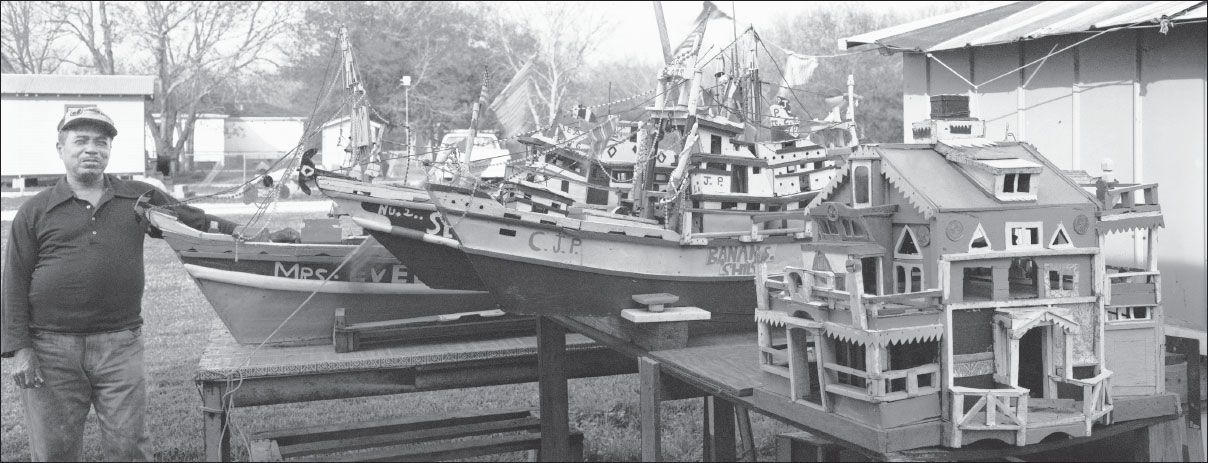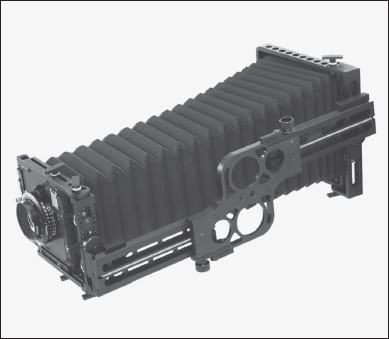All cameras are descendants of the camera obscura, an optical curiosity predating the Renaissance adopted by artists to aid in realistic drawing. As its Latin name (“dark chamber”) suggests, it is essentially a box or room with a pinhole or lens in one wall to form an image on the opposite wall.
THE DEVELOPMENT OF THE VIEW CAMERA
The earliest photographic cameras on record were made by or for the inventors of photography. Joseph Nicéphore Niépce of France and England’s William Henry Fox Talbot, two men with reasonable (but not exclusive) claim to be photography’s inventor, used simple wooden boxes. These boxes evolved gradually into today’s view camera. It occurred to Talbot in 1839 to cut holes in the camera’s back to enable him to see if the paper calotype negative was in focus. In the same year, L. J. M. Daguerre, a Frenchman who invented the Daguerreotype and claimed himself to be the inventor of photography, designed the first camera to be commercially produced. Made by Alphonse Giroux in Paris, it was also a wooden box, but assembled from two nesting boxes made to slide in and out of one another for focusing and featuring a focusing screen at the back.
The Flatbed
In 1851, an American camera introduced the bellows to common use and became recognizable as an early view camera. As a result of the bellows, the early 1850s gave rise to a number of folding camera designs. The use of a flexible bellows required cameras to have a baseboard to support the camera and until the monorail began to gain popularity in the 1940s, virtually all view cameras were a variation on the flatbed camera.

The cameras Alphonse Giroux made for his brother-in-law L. J. M. Daguerre were the world’s first production cameras. This is a photograph of an exact working replica. ■

The camera obscura predated the invention of photography by centuries. It projected an image that could be traced and was used as an artist’s aid for naturalistic drawing. ■
William Henry Jackson was one of several photographers who documented the topography of the American West in the latter nineteenth century as the land was being tamed by settlement. He used flatbed view cameras and glass-plate negatives as large as 20×24 inches in rugged terrain. ■
The desire for ever larger photographs gave rise to some absurdities in the days before enlarging. This camera was evidently assembled for only one use—to photograph a steam train onto plates 4½×8 feet. ■

This half-plate Daguerreotype camera, made around 1850 by H. J. Lewis in New York, displayed the first use of a bellows in a camera body. ■
The enlarger appeared in the 1860s, but, until the beginning of the twentieth century, its practicality was severely limited by the slow speed of the available printing materials. Without enlarging, photographs could only be made the same size as the negative, so to the early photographers, making large photographs meant using a large camera. To produce photographs in a scale appropriate to the grandeur of the American West, William Henry Jackson, Carleton Watkins, Timothy O’Sullivan, and others spent the 1860s, 1870s, and 1880s climbing pinnacles and fording streams with cameras large enough to produce 20×24-inch negatives. If a camera the size of a steamer trunk seems enough of a burden, remember that negatives in those days were made on glass plates, so the pack animals (and photographers) were also saddled with bundles of heavy fragile glass.
By the 1880s flatbed cameras had evolved into what remained the standard professional’s tool for the next 70 years. The most common form of flatbed camera had a base made of a double wooden supporting track with metal gears for focusing and used track extensions to extend the bellows for long focal-length lenses. Although many are still in use, few cameras of this type are made today. A good used flatbed camera can be an economical way to begin working in large format.
This 11×14 Sky Scraper camera made by Folmer and Schwing at the time of their merger with Eastman Kodak in 1905 is a classic example of the flatbed view camera. The back swings and tilts with no lateral movements, and the front has a vertical shift. The body parts are mahogany and brass. ■
By the end of the nineteenth century, three different designs for flatbed cameras were in common use. Most popular was the tailboard camera, with a front standard fixed to the front of the baseboard and a focusing track behind it. The fixed lens position made close-up work easier and the design eliminated obstructions to the field of view in front of the lens. Folding versions were made for portability; the track folded up on hinges just behind the rear standard. William Henry Jackson used a very large tailboard camera to make his mammoth landscape photographs in the latter half of the 1870s.
The second flatbed style, for which there is no generic name, had a focusing track, often hinged, fixed to the back of the camera and extending forward. The front standard was made to slide along this track for focusing. Often the bellows were tapered to collapse into a smaller space than did those with parallel sides. The only flatbed cameras currently produced—technical, press, and field cameras—evolved from this design.
More versatile than either of the other early flatbed designs and appearing in the 1870s were models featuring movable front and rear standards and front and rear base rails that folded up from a fixed center section.
Mahogany was the favored material for camera bodies and time has proven it a wise selection. Given reasonable care, most wooden cameras have lasted in nearly original condition. Special versions of standard designs were made of teak to withstand heat and humidity in tropical climates. Before the postwar popularity of monorails, metal construction was an occasional curiosity in large-format camera construction.

This German Leubel camera from around 1880 is a version of a flatbed view. Because the front is fixed on the focusing track and only the back moves, it is called a tailboard camera. ■
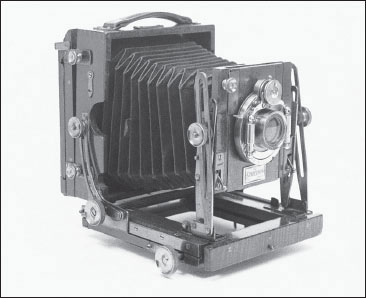
Teak was used in this tropical camera for its resistance to the effects of hot and humid climates. ■
Monorail Cameras
The first monorail cameras were probably patterned after the optical bench, a straight rail used in optical research to hold elements in precise alignment. Although several designs appeared in the 1850s, no monorail of lasting popularity surfaced until nearly a century later. All-metal monorail designs originated in the United States with the Graphic View, introduced in 1941, and in Europe with the Swiss Sinar, first sold in 1948. Recent models include Japan’s Horseman (made by Komamura), Toho, Toyo, and Wista, Cambo from Holland, Arca and Sinar from Switzerland, Germany’s Linhof, and those made for Calumet.
Some interesting variations on the basic monorail design have shown up in recent years. Toyo’s VX125 is a very compact and light camera featuring a telescoping monorail and base tilts. Linhof’s Kardan GT offers similar features. Top-of-the-line cameras like their Kardan Master GTL, Sinar’s p2, the Toyo GX, and the Cambo Legend Plus feature “yaw-free” movements and easy-to-use scales for exact calculation of swings and tilts.
Design and manufacturing differences create a wide range of prices, but the essential function of photographing is little different from one monorail camera to another. Beyond the design variations, basic differences show up in ease of use, availability of accessories, and sturdiness. The quality of your images will be entirely dependent upon the quality of your optics and your abilities as a photographer.

Certainly the progenitor of the modern monorail view, Joseph Petzval’s 1857 camera had a double-extension bellows and a triangular wooden rail. ■

The first all-metal view camera, this Graphic View 4×5 was produced from 1941 to 1948. ■
The Deardorff cameras, the best-known field cameras, were manufactured virtually unchanged from 1923 until recently. ■
DESCENDANTS OF THE FLATBED CAMERA
Field Cameras
Like a harpsichord in an era of electric pianos, the field camera seems a charming anachronism. It is the last vestige of a long tradition of wooden cameras; the beauty and warmth of the materials belie the down-to-earth practicality of this professional tool.
A field camera is a folding flatbed camera designed specifically for compactness and portability. The bed folds up into the back, creating its own storage compartment for the bellows and front. Most designs offer swing and tilt on both the front and the rear, as well as a rising and falling front. Almost unchanged from its turn-of-the-century design, the field camera is our closest link with the numerous folding flatbed cameras that were the mainstay of photography from the mid-nineteenth century until World War II. The venerable Deardorff, the name almost synonymous with wooden field cameras, was made in Chicago virtually without change from 1923 until its final failed resurgence in 1988. Deardorff’s 4×5 camera had a reversing back. The slightly larger 5×7, called a 5×7 Special, could be used as a revolving-back 4×5. Deardorff also made an 8×10 and an occasional 11×14 in the same design as the 4×5. For years, the only field cameras available were the Deardorff and the similar Gandolfi, hand crafted in Britain until recently. A surge of interest in folding cameras caused the introduction of American-made Zone VI (4×5 and 8×10), K. B. Canham and Wisner Technical Field (in several sizes up to 20×24), the import of wooden Ikeda, Ebony, Nagaoka, Wista, and Tachihara (sold as Calumet and Osaka) cameras from Japan, Shen Hao from China, and Rajah field views from India. Wista makes a 4×5 and an 8×10 available in rosewood or cherry. Toyo, in Japan, makes a sturdy metal-bodied field camera in 4×5 and, until recently, 8×10. The Toyo Field 8×10 accepts interchangeable bellows. If you need a camera with full movements, yet want one that is light and compact enough to pack and transport easily, a field camera is your best choice.

The 8×10 Toyo on the left is all metal with interchangeable bellows. On the right is the Zone VI Ultralight from Calumet. ■
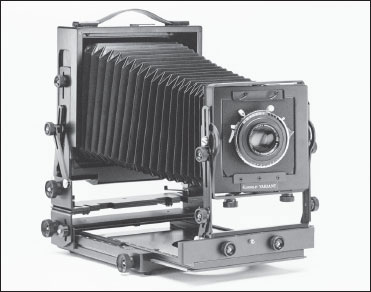
The British Gandolf is an example of a field camera, made until recently, its still-serviceable design unchangedfor decades. ■
Banquet and Panorama Cameras
In 1913, a curious offspring of the flatbed view camera appeared when Folmer and Schwing introduced their Banquet camera in Rochester, New York. This was a view camera of normal design which made abnormally shaped photographs. The long horizontal image was not, however, without precedent. From the time of Fox Talbot, the desire to depart from the classic proportions of the golden rectangle and the problem of how best to produce a wide panoramic photograph led photographers to seek some unusual solutions. Some photographers pieced together several photographs of ordinary shape, while others tried special cameras with rotating lenses, rotating cameras, curved glass plates, conical reflectors, and spherical water-filled lenses.
The simple solution, it seemed, was an ordinary camera design, altered to take a flat sheet of ordinary film in a long rectangular shape. This was the Banquet camera, made in 7×17- and 12×20-inch formats, and intended to use 13- and 16-inch wide-field lenses. The 5×12, 7×17, and 8×20 Korona Panoramic Views were introduced in 1926, the year Folmer and Schwing discontinued the Banquet. All the Banquet and Korona film sizes correspond to half (lengthwise) of one of the then-common standard sheet-film sizes. The photographer with an 8×20 Korona, for example, could cut down sheets of readily available 16×20 film.
Used Banquet and Korona cameras are frequently available from antique camera dealers, but early film holders are scarce. More recently, several manufacturers have filled the void. Two companies in the U.S., Wisner and K. B. Canham, along with Lotus in Austria, Chamonix and Shen Hao in China, have made new panoramic view cameras and film holders in 4×10, 7×17, 8×20, and 12×20 sizes.

A simple, elegant solution to the problem of how to make a long rectangular photograph is a Panorama camera—a long rectangular camera. This one is new, made by K. B. Canham in Arizona. ■
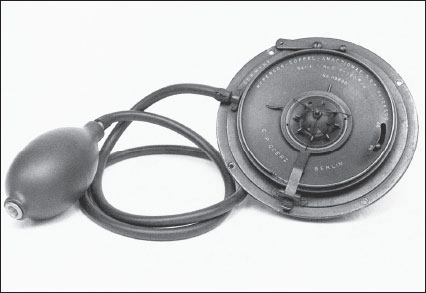
One of the most curious solutions to the wide-photograph problem was this Goerz Hypergon wide-field lens. It attempted to correct off-axis light falloff with a center-weighted propeller mounted in front of the lens. A squeeze of the air bulb set the propeller in motion just before exposure. ■
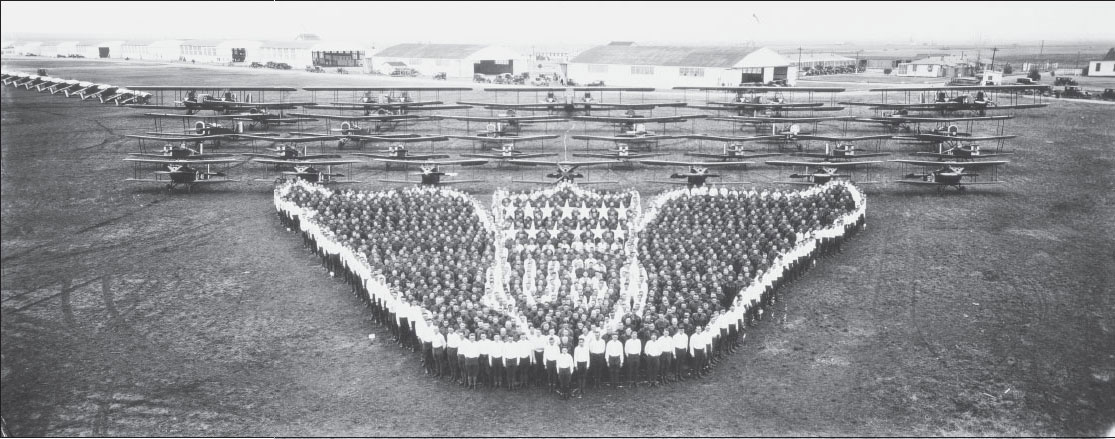
E. O. Goldbeck’s photograph of a human insignia was made in 1926 at Kelly Air Force Base in San Antonio, Texas, with an 8×20 Korona Panoramic View. ■
Allen Hess made Mrs. Evelyn, Lafitte, Louisiana, with the camera shown above. He attached a back from an 8×20 Korona to the accessory bracket of his Sinar Monorail to give him all the advantages of a modular banquet camera. ■
This self-portrait by “Weegee the Famous”shows him with his Speed Graphic Camera, ca. 1944. [Unidentified photographer, gelatin silver print. ©Weegee/International Center of Photography/Getty Images.] ■
There was no press camera but the Speed Graphic when Mrs. Frank Sinatra gave birth to Frank, Jr., in 1944. Joe Petrella used his to get the picture for the New York Daily News. ■
Press Cameras
Until the middle of the 1950s the archetypal press photographer (now called a photojournalist) was clutching a Speed Graphic. Almost unchanged from its introduction in 1912 until production ceased in 1970, this ubiquitous press camera recorded celebrations and disasters, World Series and world wars. Once film emulsions became fine and fast enough to make quality enlargements from “miniature” (an early nickname for 35mm) negatives, the press corps shifted its allegiance en masse to the smaller format. As a result, the once-proud workhorse of the front page is now in the classified ads. Versatile, durable, and inexpensive, the used press camera is undoubtedly the best value in photo equipment. At least one manufacturer still produces a Speed Graphic lookalike, but like the plush splendor of “Detroit Iron” cars of the 1950s, the halcyon days of the press camera’s popular appeal have passed.
Designed for portability, press cameras offer features useful for work outside the studio. The focusing track, on which the front standard rides, nests into a bed that folds on hinges into the rear of the camera body. When shut, the camera body itself forms a protective box—a built-in carrying case. A normal lens can be left in place with the front folded for quick setup. The ground-glass back has a hinged cover that often doubles as a focusing hood and helps further protect the closed camera against damage.
Because press cameras were used for a variety of assignments, they were often fitted with multiple viewing and focusing devices. It was not uncommon to augment the ground glass with a top-mounted viewfinder and a wire-frame sports finder, in addition to a focusing rangefinder.

The Crown Graphic, Speed Graphic’s look-alike without the built-in focal-plane shutter, was made until 1973. ■

Linhof’s Master Technika is fully adjustable and includes coupled-rangefinder focusing and a parallax-corrected viewfinder. ■
Although by 1940 Graphic models included a front shift, movements on many press cameras are limited to those used most often: the front rise and the lens tilt. Most press cameras have a drop bed, the equivalent of a rear-standard bottom-axis tilt, to allow the use of a wide-angle lens without vignetting by the bed. But because the camera was most often hand-held, these movements were largely ignored. The history of the press camera in America is the history of the Speed Graphic. It was introduced in 1912 by the Folmer and Schwing Company, which had been a division of Eastman Kodak since 1905. As part of an antitrust settlement, Kodak divested themselves of the company, by then called Century-Folmer, and it became Folmer Graflex in 1926, and Graflex, Inc. in 1945.
The first Speed Graphic was a compact, folding, large-format camera with a built-in focal-plane shutter to allow the use of barrel-mounted lenses. The mahogany bodies were made in four formats, from 3¼ × 4¼ to 5×7, and were covered with leather. The camera was probably introduced as a compact, portable large-format camera, but a model change in 1928 anticipated its use as an action camera by moving the handle from the top to the side and adding a wire frame finder. The Pacemaker series of Graphic cameras in 1947 added coupledrangefinder focusing and introduced the Crown Graphic, a version made lighter by the omission of the focal-plane shutter. Production of the Crown Graphic continued until 1973, when the company folded.
Technical Cameras
Along with the press and field cameras, the technical camera evolved from the fixed-back flatbed camera design. It incorporates the best features of its predecessors into a versatile machine for contemporary uses. As opposed to the press camera, which was built for the action photographer and, almost as an afterthought, could be used on a tripod, the modern technical camera was designed as a view camera with full movements with the option of being used hand-held.
Technical cameras all close in the same manner as press cameras: the bed folds into the back, forming a protective box. The spring back is connected to the body with four sliding pins, allowing each corner of the back to be positioned independently. This system gives the technical camera the back movements missing from otherwise similar press cameras.
The archetypal technical camera is the German Linhof Technika, which has been manufactured in Munich with constant improvements since 1936. Valentin Linhof began as a maker of shutters and by 1899 added cameras to his line. In 1910 Linhof began to make an all-metal folding camera that was the direct predecessor of the Technika. A burst of innovation produced the prototype Technika in 1936. It incorporated a fully adjustable swing back, which had been patented two years earlier. The Super Technika of 1946 introduced a built-in rangefinder with cams to couple it to interchangeable lenses of various focal lengths. The current Technika models, in 6×7cm and 4×5, incorporate rear swing and tilt and a full-movement front with coupled-rangefinder focusing and an accurate viewfinder corrected for parallax error (parallax is the difference between what is seen by the lens and by the viewfinder due to the slight difference in their vantage points). Technika cameras are remarkable examples of engineering and manufacturing precision, and sell for almost as much as a new car. At one time the top-of-the-line Technika even offered automatic focusing.
A much less expensive 4×5 technical camera than the Technika is Wista’s 45, the only similar large-format rangefinder camera made today. It is also made in versions without lens swing, interchangeable bellows, and coupled rangefinder. The Horseman is a useful, smaller version of the technical camera, designed for medium format—120 and 220 roll film only. Horseman also makes the HD Field in 4×5—like the Wista, but not available with a rangefinder.
If you need a portable camera with full movements, more sturdiness than a field camera, and the option of hand-held use, you will want to shop for a technical camera.
New Flatbed Designs
A resurgence of interest in view cameras has given rise to new designs that combine the unrestricted functionality of a monorail camera with the portability and convenience of a field camera. Cameras by Ebony in Japan and K. B. Canham in the U.S. fold compactly for transportation and storage but provide full movements and interchangeable bellows. Ebony cameras are made from exotic hardwoods while Canham makes some models in wood and others machined from aircraft-grade aluminum.
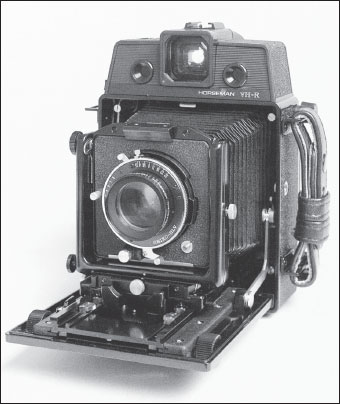
The Horseman Technical Camera has the features of a Linhof Technika but uses nothing larger than 120 and 220 roll film. ■

The CF in the name of Toyo’s 45CF field camera stands for carbon fiber. This space-age composite material gives the camera’s lightweight body strength and rigidity. Its modest price makes this camera an attractive choice for students and beginners. ■
Shown here from below, the Canham DLC45 is a new flatbed design that incorporates most of the advantages of a monorail while still folding into a compact package like a field camera. ■

Recently discontinued, Polaroid’s MP-4 is a version of a vertical process camera called a copy camera. It is well suited to making slides and copy negatives from flat originals and can be adapted to make digital copies. ■

Nu-Arc’s horizontal process camera seems distant from the nineteenth-century flatbeds, but the lineage is direct. These cameras have almost all been replaced by electronic scanners. ■
Process Cameras
The needs of the graphic arts industry generated a number of specialized camera designs based on the flatbed view camera, called process cameras. Sometimes called copy, repro, or stat cameras, vertical and horizontal process cameras were designed specifically to make reproductions near the original size of flat copy.
Before it became completely digital, the printing industry used process cameras to make halftones and color separations. Both are dot-patterned images on high-contrast litho film that were “burned,” or exposed, directly onto the printing plate for an offset press. These halftone negatives are now generated, when they are needed at all, by specialized machines called imagesetters, but at one time at least one of these dot-patterned negatives was necessary for every photograph reproduced in print. There were probably more process cameras in use than all other view cameras combined. These cameras were often permanently installed in a room with the bellows, lens, copyboard, and lights separated by a wall from the back. The back would be in a separate room, usually a processing darkroom. A process camera was used only for its ability to photograph onto large sheets of film and was therefore designed to have no movements.
A small, freestanding, vertical process camera for a designer’s office or typesetting shop might have accommodated film up to 14×17, while a larger built-in horizontal model for a production printer would use film as large as 60 inches square.
Lenses specially designed for process work (apochromats, p. 127) are optimized by the lens designer for the most common reproduction ratios and carefully corrected against aberrations for the printer’s specific primary colors. Process lenses were made in an array of very long focal lengths (commonly up to 1800mm and sometimes longer) to cover the large sheets of film common in the industry. These lenses were almost always mounted in barrel, since the exposure in process cameras was controlled by switching the lights on and off.
A reflex camera produces an image on a ground-glass surface parallel to the optical axis by placing a mirror at a 45° angle to the light path. This allows the film to be in place during viewing and focusing. Although the principle predates photography—it was introduced in the seventeenth-century camera obscura—the design emerged slowly. Today, however, (digital) reflex cameras dominate the serious photography market.
The first camera with a reflex design was patented in 1861 by the English photographer Thomas Sutton. Sutton’s camera had an internal mirror to reflect the lens image up to a horizontal ground glass set into the top of the camera. Before exposure, the mirror was swung on hinges from its viewing position into a position covering the opening for the ground glass, making the camera’s interior lighttight. Sutton’s camera was not popular, due in part to the wet-plate process then used. Because the plate needed to be sensitized immediately before use (and exposed and developed while wet), there was little advantage to making it possible to view and focus rapidly. With the emergence of practical dry plates in the 1880s came a flood of hand cameras and the reflex became a popular design.
In 1901, the Folmer and Schwing Company, which also made the Speed Graphic, introduced the Graflex, which became the most popular series of large-format single-lens-reflex cameras. First made in four sizes from 4×5 to 8×10, the Graflex family was manufactured in several incarnations until it was finally discontinued in 1963. In the six decades of its production, the features of the Graflex were modernized slowly, but its basic design remained unchanged. It was similar to the Sutton camera, with a large internal reflex mirror, and designed so that its top viewing hood (to darken the area around the ground glass), lens, and bellows would fold into the body, forming a protective, portable box in the shape of a cube. Versions of the basic camera included double-lens stereo cameras and “Big Bertha” Graflexes adapted to lenses with focal lengths as long as 40 inches. The Super D was the last Graflex model and, in 4×5 format, remains a useful camera.
Paul Strand’s photograph of Alfred Stieglitz from about 1929 shows him with his Graflex, with which he probably made his Equivalent series of cloud photographs. ■
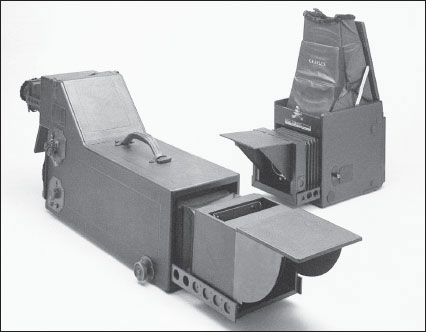
The Naturalist Graflex was a large-format singlelens-reflex Graflex with a 600mm lens. A similar camera called “Big Bertha” was a common sight with press photographers at sporting events. The standard Graflex shown here was the last model made: a Super D. ■

This photograph of Dorothea Lange taken by Paul S. Taylor in 1934 shows her with her 4×5 single-lens-reflex Graflex. She probably used this camera to make her famous photograph Migrant Mother in 1936. ■

The only large-format twin-lens-reflex camera made today is the Gowlandflex. ■

This odd-looking hybrid once made by Arca is a single-lens-reflex monorail view camera. ■

The Cambo-Wide is a special-purpose 4×5 camera made to take only a 90mm wide-field lens. ■
An unusual set of twin-lens reflex cameras were made and marketed by Peter Gowland in California. First made by Gowland in 1956 for his own use in photographing “glamour” models, the Gowlandflex was produced and sold in 4×5 and 5×7, with a wide-angle version available in 4×5. These cameras used matched lenses in pairs, one to form an image on a ground glass for viewing and the other to form an image on the film. With a twin-lens camera there need be no delay between final viewing and exposure because the presence of a film holder does not block the ground-glass screen. A cam on each camera corrects parallax error, which increases with decreasing object distance. A similar TLR 4×5 camera was made for a short time in Holland by Cambo.
Most advances in the equipment currently available for view camera photographers have been small refinements in a system that has been stable for more than a century. Glass lenses now have fewer aberrations, mechanically-adjusted cameras are more precise, and silver-halide films are sharper and faster than ever before. But the basic character of camera, lens, and film is very much as it has been since the dawn of the dry plate era.
Innovations in electronics rapidly revised the entire field of photography for users of small-format and view cameras alike. The computer that was once used only for tasks having a mathematical bent, like accounting or engineering, became essential to the printing and publishing industry. Every photographer whose work is destined for the printed page—almost every serious photographer—is working with digital images. Photographic images that end up printed in ink—for books, magazines, posters, or brochures—are converted into an electronic, digital form somewhere between the exposure and the making of the printing press’s plate. For images originally committed to film, that conversion is done by scanning, a way of reading the optical information from an original photographic print, negative, or transparency, sometimes done by the printer just before making the plate.
Scanning an image before it leaves your studio and presenting it to the client in electronic form gives you more control over that conversion and makes it possible for you to further manipulate and alter the photograph. Image-manipulation software gives you the tools to repair defects, to remove unavoidable reflections or shadows, or to merge objects and backgrounds from several different images. It is also advantageous in almost all photographer’s studios, to record (or capture) the photograph with a digital camera, bypassing entirely the use of film. Film and darkroom-based photography have entered the realm of “alternative” processes—no longer commercially necessary but no less rewarding or pleasurable for the practitioner.
Digital Image Capture
Although it is still somewhat more complicated than it sounds, a photograph may be made in digital form by replacing the film holder or spring back in a standard view camera with a device that records light electronically. These high-quality digital camera backs are made by several companies and, at the time of this writing, cost as much as a new automobile. Because the direct digital recording of an image saves the time and cost of film and processing, the technology found its first practical use in high volume studios such as those that photograph for mail-order catalogs. As technology improved and costs declined, direct digital photography became practical for other specialties, and smaller-format digital cameras supplanted almost entirely the professional use of view cameras.
The business workflow advantages of direct digital recording are certainly of interest to commercial photographers, but electronic recording offers a subtle but important qualitative improvement as well. The contrast, or range of brightness values, that can be captured on conventional film is about five stops (32:1) for transparencies and about seven stops (128:1) for negative films. With electronic capture, this measure of available contrast is called dynamic range, and some of the available digital adapters for professional cameras claim a dynamic range of fourteen stops—greater than 10,000:1. (See photo by Stephen Johnson, page 3.)
Digital camera backs fall into two distinct categories, based upon the light-sensitive recording mechanism. Currently almost all digital image recording uses sensors called CCD (Charge-Coupled Device), or CMOS (Complementary Metal-Oxide-Semiconductor). Each is made up of individual light-sensing cells (photosites) that are the elemental building-blocks of a digital image. These cells may be arranged in a one-cell-wide line, called a linear array, that is moved across the image area in a scanning back, or they may be arranged in a rectangular group, called an area array, that faces the lens like a sheet of film.

The now-discontinued PhotoPhase scanning 4×5 back from PhaseOne fit any conventional view camera’s spring back and produced an RGB picture file as large as 380MB from its 7×10cm recording surface. It would make a preview image in ten seconds and capture complete information in as little as four minutes. ■
Scanning Back
CCD and CMOS cells are essentially monochromatic—each converts the relative brightness of the whole spectrum of light into a single electronic value, as a spot meter does; for color information they must be used with filters in order to record the brightness of specific colors. Scanning backs for view cameras use three linear array sensors, one filtered for each primary color, to render a full-color image in one pass (or scan) across the image surface. A typical scanning back for a 4×5 camera might have three 5000-element linear arrays that read in 7000 steps, meaning that the total scanned image would be a grid of 5000×7000 (or 35 million) discrete, measured spots. For a full-color image, each spot would have three recorded values, one for the brightness of each of the separation primaries—red, green, and blue—at that spot.
Storing a hundred million or so pieces of information takes a computer storage device of significant size, so scanning backs have been designed with a direct wired connection to a host computer that both controls the scanning mechanism and stores the picture. The scan itself takes minutes, making undesirable any movement of subject or camera. These qualities make this generation of scanning back unlikely, although not impossible, to prove useful in the field. In the studio, “hot” lights must be used for continuous illumination.
Area Array Back
A different approach to recording an image electronically, the one that dominates the landscape of digital photography, is the area-recording CCD or CMOS sensor. The area array is a grid of elements that, like film, can record an image over its entire surface simultaneously. Area array chips with a light sensitivity (or ISO) vastly greater that of fast black-and-white film form the basis of digital cameras that can be hand-held. In the studio or in the field, area array sensors allow the use of strobe illumination.
Large, high-resolution area array sensors are more expensive to manufacture than a linear array; defects in the manufacturing process cause a high rejection rate. And at the time of this writing, no area array sensors larger than about 4.5×6 cm are commercially available. These sensors are made predominantly for medium-format cameras but may also be fitted into backs for the view camera. Their size, smaller than 4×5, necessitates shorter focal-length lenses and gives the photographer a commen-surately smaller ground-glass image for viewing and focusing. In the studio, these backs are often used “tethered,” or connected directly to a computer. The sensor transmits the image to the computer, which displays it on a monitor for viewing, focusing, and proofing. The files produced by area backs are generally smaller than those from 4×5 scanning backs, therefore the resolution is lower. The cells in area array sensors do not capture color information directly, so each cell is covered with a red, green, or blue filter. The color in a full-color image must be calculated by interpolation after the capture, so the color information is less accurate than the luminance, or brightness, data. Scanning backs capture luminance and color equally.
Cameras for Digital Photography
Professional-quality digital-capture backs have given rise to a new generation of view cameras. Typical of these cameras is Sinar’s p3, shown at right. The Cambo Ultima D, Linhof M679cs, Arca Swiss Rm3d, Plaubel PL69D, and Horseman X-Act-D share similar features. Because the area array capture sensor is about the same size as medium-format film, these cameras are similar in size to older monorail cameras designed for 120 roll film or 6×9cm sheets. Precision and stability, however, are considerably improved over previous generations of monorails, and these cameras are designed to work in an integrated system that includes digital back, electronic shutter, and host computer.

Mounted to this Linhof camera is the Creo Leaf Volare, an area array CCD back that captured 2048×3072 pixels. It made an RGB file with three successive exposures—one every 1.3 seconds—through a rotating filter assembly in front of the lens. ■

Sinar’s p3 has extremely precise adjustments and a high degree of stability, advantages for both film and digital capture, and at about two-thirds the dimensions of a 4×5 view camera it is the right size for use with the current generation of digital capture backs. The camera and back form an integrated system that transfers data and power directly through the camera between shutter and digital back, and then on to the host computer. ■

The X-Act-D from Horseman was a digital camera system intended for use with a tethered computer. It was replaced by the similar X-Act 2 medium-format monorail camera, which accepts digital backs from several manufacturers. ■





